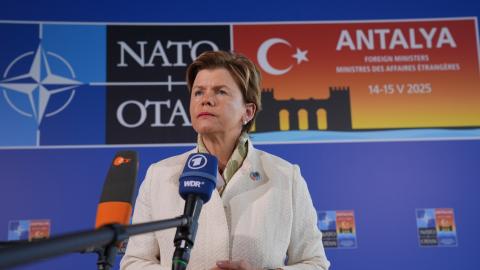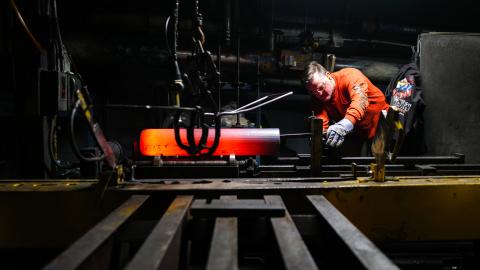For a defense planner provided with limited resources to distribute among numerous priorities, risk calculations must be made. This is the process at the heart of the entire defense budgeting system. In times of plenty, the decisions are somewhat easier, though resources are always "scarce" to some degree.
In the present environment, those resources are particularly scarce. This statement causes many a jaw to drop, what with a base budget in the neighborhood of $500B and contingency funding atop that. Readers of this blog are less likely to stare agape at the screen, as you recognize that even with all that money being spent, the military requirements of the world's leading democratic power are considerable.
With the release of the FY15 Defense Budget earlier this month, we get a much better understanding of what assuming additional risk looks like. The case in point is the Navy's Tomahawk Land Attack Missile (TLAM) program. First brought to my attention by the reporting of the estimable Chris Cavas, it seems that the TLAM program will acquire 100 additional missiles in FY 15, and then no more. From Cavas' article:
"Weapons procurement showed striking reductions from last year’s plans. Then, the Navy planned to buy 980 Tactical Tomahawks, the primary cruise missile in use throughout the fleet. The new plan shows only 100 missiles in 2015 and none thereafter. The reduction reflects shifting investment to a new next-generation land attack weapon, said Lt. Caroline Hutcheson, a Navy spokeswoman at the Pentagon, who also noted that the current inventory of Block IV Tactical Tomahawks exceeds combat requirements. A recertification line for existing missiles will be established to retain effectiveness of current TacToms, she added."
When this piece came out in the first week of March, a logical conclusion would have been that the "next generation land attack weapon" would be found in some other procurement line item, and that its acquisition would pick up where the TLAM left off. This sort of thing happens, it is part of the sturm and drang of the defense industry. A successful system or weapon has a certain program life, and then is replaced by updated technology. But this is not the case. THIS is the case (from the Budget Request and Inside the Navy (behind firewall):
“Funding is provided for a Next Generation Land Attack Weapon, a weapons system that is long-range, survivable and can be launched from multiple surface and submarine platforms,” states the budget request. “NGLAW will incorporate evaluated existing and emergent technologies to support an improved strike capability with an initial operational capability no later than 2024.”
The Navy plans to begin an analysis of alternatives for the Tomahawk follow-on capability in FY-15, with a goal of awarding a technology demonstration contract -- or contracts -- during the second quarter of FY-16, according to the budget. The program would begin engineering and manufacturing development during the first quarter of FY-18."
This is what assuming additional risk looks like. This is what hard working planners must do when faced with scarce resources. One year ago--in the FY14 Budget submission--these planners believed we needed 980 more TLAMS over the course of the FYDP. One year later, they had to choose differently. In order to create the funding necessary to design, compete and build a follow-on land attack weapon, the Navy must cease production years early of one of its most important, useful, flexible, and responsive offensive weapons. In doing so, funds are "created" that can then be applied to the research and development of the follow on. A hard decision made by smart people when presented with no good options. The decision is made somewhat less ugly by the fact that there is an inventory of these weapons built up after years of production (and expenditure). That number is of course, classified, as it should be. But starting in 2016 through 2024, that inventory will diminish each time a missile is fired. This is risk.
So why am I writing about this. First, to make sure readers know the kinds of least bad decisions that people in the Pentagon have to make--on a daily basis. Many of you already know it, but perhaps some don't get to drill down like this. I know the people who work these issues--they are really smart and in most cases, they wish they had better options.
Secondly, I think this is an unwise decision as a matter of strategy.
I believe that the country needs to put additional energy toward deterring the war it cannot afford to fight, and that is a war with China, Russia, or China and Russia. In order to best deter such a war, it must be well-prepared to wage it. Calculations of risk that involve diminishing stocks of precision guided munitions without the industrial capacity to quickly replace them should be viewed with concern. It is not 1939. We do not have endless untapped industrial capacity that will build 50,000 airplanes and 6000 ships and boats. We have limited production lines in incredibly high-tech factories that rely on a precious supply of skilled workers who are not reproducible overnight. Any war with another major power will expend PGM's at a rate our industrial base will strain to replace. Steady peacetime procurement of these specialized weapons not only makes the US better prepared to wage war--should it come--but it sends powerful signals of readiness and will that serve to deter war in the first place.
At some point we must recognize that the height of national strategy is NOT the pursuit of the most efficient allocation of resources. It is the advancement and sustainment of national interest. In taking on this additional near-term risk, the United States efficiently allocates resources while sending yet another message of quiescence in the face of an increasingly troubled world.
















